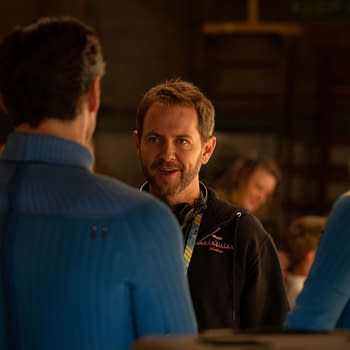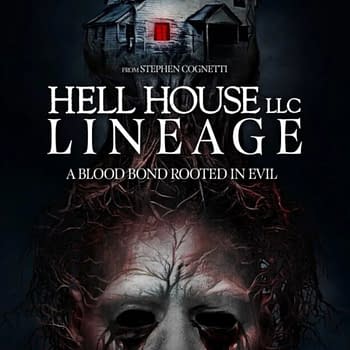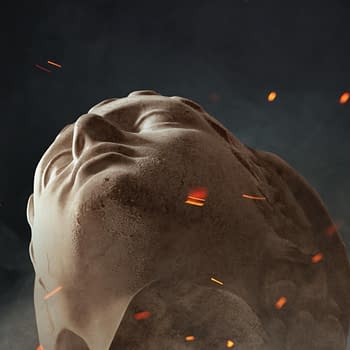Posted in: Movies | Tagged: jack nicholson, rodney ascher, stanley kubrick, the shining
We Know What The Shining Is Really About, And We're Going To Tell You. Perhaps
As the provisionally-titled "horror expert" at Bleeding Cool, I was sent along to a screening of Room 237 at the London Film Festival 2012, and then to an interview producer Tim Kirk and director Rodney Ascher. Prior to the screening, I was only peripherally aware of the entire library of theories surrounding Stanley Kubrick's 1980 horror film The Shining. That is to say, I'd sort of assumed that it must have been analysed to death by generations of film studies students, but I was unaware that there are people who seem to have dedicated half their lives to answering out one question: what is this movie really about?
Room 237's five interviewees – Bill Blakemore, Jay Weidner, Geoffrey Cocks, Juli Kearns, John Fell Ryan – represent some of the most enthusiastic of the enthusiasts, and they all seem to agree on one thing: The Shining is not just a movie about a psychic kid and a haunted hotel. According to these experts, the story that we see is only the outer surface, and Kubrick hid the real meanings in everything from the posters on the wall to numerous "continuity errors" that most people would miss on a first viewing. But not on the fiftieth viewing.
Or the hundredth viewing.
Or the frame-by-frame viewing where you slow the film down to 1/24th the normal speed in order to better study each individual frame.
Or the viewing where the film is played backwards and forwards, simultaneously, superimposed so that the final shot is laid over the opening shot.
We're not kidding. Room 237 is as much a story of how people became trapped in the film through obsessively studying it, as it a genuine exploration of any possible hidden meanings. Kubrick himself famously did not like to discuss the intended themes or meanings or his films after they were completed, and Room 237's interviewees believe that even the answers he did give may have been deliberately misleading or false.
The films cites this interview section as an example. Here's Kubrick explaining why he changed the number of the gruesomely haunted hotel room from 217, the room number in Stephen King's novel, to 237.
The exterior of the hotel was filmed at the Timberline Lodge, near Mount Hood, in Oregon. It had a room 217 but no room 237, so the hotel management asked me to change the room number because they were afraid their guests might not want to stay in room 217 after seeing the film.
According to Room 237, a little probing revealed that the Timberline Lodge does not have, nor has ever had, a room 217. So if not for the sake of faint-hearted hotel guests, why change the number at all?
Naturally, its because if you multiply the numbers 2, 3, and 7, the result is the number 42, which is a reference to the year 1942, the year in which the Nazis decided upon the 'final solution' for extermination of the Jews. If you think that assumption is a little tenuous, interviewee Geoffrey Cocks has also written a book detailing all the examples of veiled references to Germany and the Holocaust that can be found in the film.

Theory #1: It's about the suffering of the Native Americans
This might be the easiest pill to swallow out of all the ideas presented in the film, since it is explicitly stated by hotel owner Mr Ullman that the Overlook Hotel was built on the site of an old Indian burial ground. But the far more significant clue, at least according to sometime ABC reporter and Room 237 interviewee Bill Blakemore, are the tins of Calumet baking soda seen in the Overlook's larder, not to mention a conveniently-placed painting of a Native American tribesman in full headdress, and an extended dissolve shot which superimposes the image of a janitor sweeping a floor over a section of forest that has been cleared to make room for the Overlook's grounds.
Is Jack Torrance's growing violence towards his family a metaphor for the Pilgrims' betrayal of America's Natives? Or is it the other way around?
Theory #2: It's all about sex, baby
This interpretation owes some of its foundations to the fact that Stanley Kubrick and co-writer Diane Johnson studied Sigmund Freud's essay The Uncanny before embarking on the screenplay for The Shining. The Uncanny is prescribed reading for most courses on horror and actually doesn't focus all that much on sex, save for the lengthy tangent on castration complex towards the end. It is particularly relevant to The Shining because of Freud's study of the semantics of the German word unheimlich, which literally translates as "unhomely", and his analysis of the word as a sub-species of its opposite.
As we have seen some languages in use to-day can only render the German expression 'an unheimlich house' by 'a haunted house'.
Room 237 dips in and out of psychoanalysis on its journey towards a complete decoding of what the interviewees perceive to be Kubrick's "riddle", and the ways in which the Overlook Hotel's uncanniness is established subliminally by the presence of, for example, an impossible window in the hotel's office, or steadicam shots that cut smoothly between the basement and the third floor without the audience realising.
Of course, if that doesn't do it for you, there's always Stuart Ullman's paper-tray boner.
Theory #3: Stanley Kubrick faked the moon landings and The Shining is his confession
One can't help but suspect that this interpretation was included in Room 237 as a reality check for any of the more gullible viewers who had been nodding along enthusiastically so far; a cautionary tale about the dangers of projecting your own beliefs onto a film critique.
Director Rodney Ascher declined to comment on this, saying that he would never consider any of the theories in the film to be more or less plausible than the others, "at least not in an interview".
The evidence for the jury includes Danny Torrance wearing an Apollo 11 jumper, a reading of the conversation between Jack Torrance and Stuart Ullman as an analogy for Kubrick's deal with NASA, and the possibility that room 237 is a reference to the 237,000 miles between the Earth and the Moon. Somewhat ironically, the main proponent of the moon landing theories, Jay Weidner, says on his website that, "I have never really thought that The Shining was a very good film."
Just good enough for a few hundred viewings.
What's our verdict on Room 237? Well, Bleeding Cool critic Patrick Dane listed it as one of his recommended films for LFF 2012; Brendon thinks it's at least largely hilarious but could have used a trim and would maybe have worked just as well as a podcast for most of its running time; and I'd contend that the film is a fascinating watch for anyone interested in film analysis, film over-analysis, and of course for fans of Stanley Kubrick and The Shining.
Personally, I think people should feel free to posit as many theories as they like, no matter how far out they might be. As legitimate critique of The Shining, Room 237 is betrayed by the interviewees' regular and unabashed uses of intentional fallacy with statements along the lines of "Kubrick did this because" and "Kubrick was trying to say this", but as an examination of of the hypnotic and addictive effects of film it's quite fascinating.
Room 237 is out on limited release across the UK from Friday 26th October. Next week, the longer cut of The Shining is released in Blighty too.
The 'analysed' images from The Shining that I used above were created by John Fell Ryan and Juli Kearns. Here's the trailer for the film.
[youtube]http://www.youtube.com/watch?v=sJr7TEVvjqw[/youtube]

















